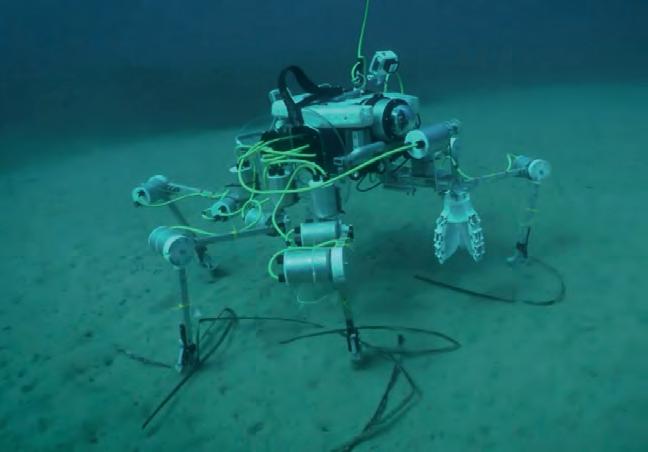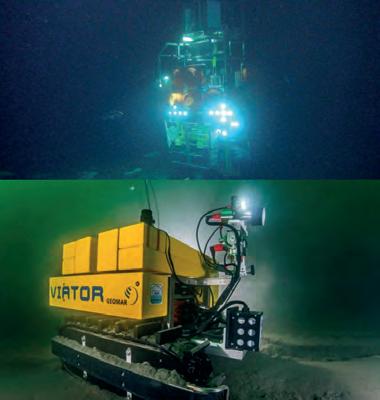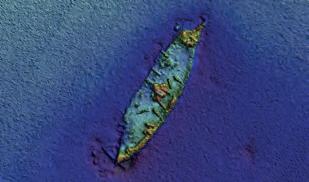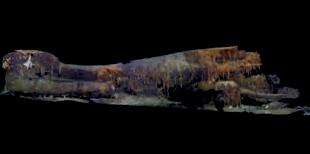
13 minute read
The Synergies of Exploring Deep-sea Ecosystems and Icy Moons
Deep-sea Robotics Development and Space Technology Cooperation
The Synergies of Exploring Deepsea Ecosystems and Icy Moons
During the past years, terrestrial and extraterrestrial ocean research have increasingly joined forces to merge expertise and technical solutions in the exploration of marine systems on Earth and in space. This includes solutions for robotic applications, autonomy and sensor integration, as well as data analysis. These synergies in biomimetic design, platform artificial intelligence (AI) and life-tracing sensor packages will be applied to the monitoring and surveillance of environmentally delicate habitats on Earth such as cold-water coral reefs or fishing grounds, as well as decommissioning sites. Thus, marine scientific and industrial offshore infrastructures may provide innovative test-bed services for robotics and sensor development.
DEEP-SEA ROBOTICS AND ICY MOONS
Marine and space ocean research largely focus on satellite- and buoy-based monitoring. However, recent advances in robotic design, autonomy and sensor integration are creating solutions for the exploration of deep-sea pelagic and benthic environments that are transferable to the vast extraterrestrial oceans of the icy moons Enceladus and Europa. Those water bodies are similar to terrestrial marine systems in terms of pressure, gravity and geothermaldependent activity, internal tidal bulges and constant darkness, and also share the presence of hydrothermal vent activity (as revealed by Galileo, Cassini-Huygens and Hubble Space Telescope space missions). Fractures on icy surfaces are the product of large geysers emitted as cryovolcanism; in other words, high pressures and strong geothermal gradients produce large fluxes of hot water to be transported to the surface through cracks and crevasses in the ice cap. Due to decompression shocks, water suddenly evaporates and freezes once it emerges into space, falling back to the surface as snow.
The exploration of life on icy moons is regarded as a result of the propitious momentum introduced by space agencies, but a contribution will also be made by the latest developments in deep-sea robotics, which in turn may benefit from space research solutions. For example, sensor packages based on optoacoustics, passive acoustics and omics (eDNA) that are currently used for deep-sea ecosystems research may represent off-theshelf solutions for the bioprospecting of exo-oceans’ putative life at ranges of sizes of bacteria and beyond. Given the geological timeframe of exo-oceans’ existence and venting activity (which is comparable to that of Earth), a bold thought would be to consider that extraterrestrial organisms could even be present within the megafauna size ranges, and even with some level of morphological analogy (i.e. species of different phylogenetic origin are similar since they have responded to shared selective pressures). Extraterrestrial fauna may resemble sessile or motile morphological
Figure 1: The bioinspired underwater legged robot SILVER2 during field trials in Savona, Italy. Thanks to its springy legs, SILVER2 is capable of agile locomotion on several types of sediment and exhibits low environmental disturbance in terms of acoustic footprint and impact on the sediment. Here, SILVER2 is equipped with a soft robotic gripper to enable the collection of delicate objects of arbitrary shape. (Courtesy: Igor d’India)

Figure 2: Main steps of the pipeline for eDNA and imaging data integration. The eDNA is collected from the water or sediment and processed through metabarcoding protocols. This step includes several bioinformatics preprocessing actions before going through an automated DNA barcode classifier pipeline. The images acquired on cameras contextually to eDNA sampling are post-processed through an image classifier routine. Both protocols need independent reference repositories to train the machine learning classifiers before the cross-checking of the taxonomic assignments derived from eDNA and images. (Image from Stefanni et al., 2022)
designs of our marine organisms within major marine phyla, such as Porifera (sponges), Arthropoda (e.g. crustaceans), Mollusca (e.g. octopus), Cnidaria (corals and jellyfishes), Anellida (worms) and even Chordata (e.g. fishes). In this scenario, marine research is currently establishing growing high-tech benthopelagic networks of cabled and uncabled observatories and their docked mobile multiparametric platforms (i.e. AUVs and ROV, as well as crawlers, rovers and biomimetic robots) for reasons varying from astrophysics to neutrino detection (i.e. the neutrino telescopes of KM3NeT) and ecological, oceanographic and geochemical monitoring (e.g. Ocean network Canada-ONC, European Multidisciplinary Seafloor and water column Observatory (EMSO) and Ocean Observatories Intitiative-OOI). Marine platforms have increased their autonomy capacity in recent years to match their space counterparts, but their increasingly biomimetic design may make it possible to study complex deep-sea and exo-oceans environments using the highly integrated life-tracing, oceanographic and geochemical sensor packages described above. Exo-ocean exploration implies a technological challenge of much higher complexity than the exploration of any deep-sea location. Platform and sensor payloads are likely to constrain their use for exo-ocean exploration for the coming decades, and the penetration of large ice caps will require robotic carrier solutions (e.g. cryobots) bearing a tool to carve tunnels kilometres long. Here, the future development of deep-sea robotics is presented in relation to the engagement of space technologies in three major research areas: biomimetic structural and energetic design, AI, and miniaturization of life-tracing sensor technologies.
BIOMIMETIC STRUCTURAL AND ENERGETIC DESIGN
The exploration of extreme environments such as terrestrial abyssal areas and exo-oceans requires innovative platforms that employ locomotion modalities beyond those of traditional assets (e.g. AUVs, crawlers and rovers). It also requires energy provision for longer mission autonomies and upgrades in cooperative behaviour (i.e. groups of units, to maximize the effectiveness of missions).
The development of biomimetic legged platforms that employ agile arthropod-like locomotion could dramatically enhance mobility on irregular terrains such as hydrothermal vent fields, and allow these platforms to anchor to the substrate and even sense using their limbs. The adaptation to dynamically changing, rough terrains and high pressure can also be achieved with new soft and lighter materials with a density close to seawater.
Another major challenge related to robotic autonomy is energy provision, which presently focuses on the development of efficient but often large batteries or hydrogen source equivalents such as hydrogen peroxide (H2O2) fuel cells. However, organisms rely on the creation of energy through biological processes, and this can be replicated by an artificial metabolism for a renewable in situ energy provision, such as via the processing of substrata (feeding-like functions), which may also be of potential benefit to space exploration. This could be based on a new generation of energetically autopoietic microbial fuel cells, but these represent a threat to space missions according to the contamination protocols of the Committee on Space Research (COSPAR). In the near future, the bacterial components may be removed and biochemical reaction routes inferred with reverse engineering approaches based on AI.
PLATFORM AI IN MISSION AUTONOMY AND DATA PROCESSING
The traditional command cycle for autonomous robotic marine platforms involves human operators sending fixed commands to the vehicle and the vehicle executing those commands and transmitting the acquired data to a ship or shore. However, this is increasingly unfeasible as such platforms work at increasing ocean depths, and is impossible in exo-ocean scenarios. AI and long-term autonomy are therefore required for key functionalities of long-term missions in operational contexts where data transmission is constrained (e.g. large oceanic depths, shielding ice sheets and astronomical bodies, and over immense distances). Such AI upgrades are required for navigation and trajectory planning, adaptive sampling and sensing, as well as the processing and summarization of very large amounts of heterogeneous data in real time. Hardware architectures capable of controlling sensors and executing algorithms in real time for contentbased data interpretation independently from remote computational resources are the core of the edge computing paradigm. For example, terrain relative navigation and simultaneous localization and mapping (SLAM) methods can be used to assist in navigation when acoustic ultra-short baseline (USBL) and single beacon signals are not available for localization. These have the benefit of being independent from any external infrastructure, but the limitation that local coordinates must ultimately be referenced back to a global frame. Deep-sea operational test beds will be critical in the development and refinement of robust navigation solutions for use in exo-oceans.
Furthermore, as marine robotic platforms acquire a huge amount of heterogeneous data, a relevant effort is being dedicated to autonomous data processing. AI applications must not only be capable of detecting and extracting useful information to reduce memory storage and to
ease communication activities, but they also need to autonomously explain why such information is relevant and how it has been extracted from the data. Autonomous on-board interpretation of data and recommand of the vehicle, as in the case of adaptive sampling/ sensing, have been developed in contexts where no a priori scientifi c knowledge of environmental features is available. In such cases, methods for the adaptive online exploration of target features of interest will be required to autonomously evidence new observations, based on a history of previous ones.
LIFE-TRACING SENSOR PACKAGES
In astrobiology, the effort in the integration of sensor payload is currently centred on micro-organisms, with conceived prototypes integrating molecular analyses with the micro-imaging and spectral analysis of liquid samples. A deep-sea-inspired technological development may contribute to shifting the focus of astrobiology research from microcellular to multicellular and larger-sized organisms.
While marine research is developing omics sensors to trace environmental DNA/RNA (eDNA/eRNA), the exo-ocean community is developing direct and indirect methods of detection of environmental nucleoside alternative structures, such as xeno-nucleic acids (eXNA). This is paving the way for the creation of in situ omics sensors that can scout for signatures of life in extreme environments (e.g. hydrothermal vents). This life-tracing capability in the deep sea will increasingly combine image and molecular sensor technologies into highly integrated payloads (Figure 2). Such a development will converge with the in situ microfl uidic sampling capability in the near future. Microfl uidic sensors are true molecular laboratories. Presently, in situ microfl uidic sampling capabilities are far from being achieved in the marine medium, but they are relevant for the identifi cation of life within ice shells and exo-oceans on icy moons. Such sensors are assembled for the detection of molecules (e.g. amino acids), biopolymers (e.g. lipids as universal markers of life and carbohydrates as proxies for photosynthetic activity) or nucleic acids, using protocols integrated with magnetic particles and the single-channel structure nanopore for sequencing.

Figure 3: The deep-sea crawler MANSIO-VIATOR is capable of performing autonomous monitoring missions on the sea fl oor. It consists of an autonomous crawler and its garage.
CONCLUSIONS: TOWARD A NEW CLASS OF BLUE SERVICES
In the decade of the restoration of the ocean ecosystems, environmental exploration and monitoring technologies are increasingly taking centre stage. By combining marine technologies with space robotics exploration solutions for the monitoring and surveillance of environmentally delicate habitats (e.g. cold-water coral reefs) or at oil and gas platform decommissioning sites, a new framework for dialogue emerges for robots and sensors within three major research topics of interest to produce a new class of blue services. For example, offshore industries could strongly benefi t from robotic developments for the surveillance and maintenance of their infrastructures. At the same time, marine scientifi c and industrial offshore infrastructures may provide innovative test-bed services for robotics and sensor development.
ACKNOWLEDGEMENTS
This research was made possible with the help of the following colleagues: Simone Marini (CNR-ISMAR, Italy), Laurenz Thomsen (Jacobs University, Germany), Jan Albiez (Kraken Robotics, Canada), Peter Weiss (Spartan Space, France), Marcello Calisti (University of Lincoln, UK), Luca Mirimin (Galway Mayo Institute of Technology, Ireland), Fabrizio Vecchi (SZN), Cecilia Laschi (National University of Singapore), Andrew Branch (Jet Propulsion Laboratory, USA), Evan B. Clark (Jet Propulsion Laboratory, USA), Mar Fleixas (Jet Propulsion Laboratory, USA), Bernard Foing (ILEWG EuroMoonMars, Leiden University, The Netherlands) Armin Wedler (Institut für Robotik und Mechatronik, Germany), Damianos Chatzievangelou (ICM-CSIC), Michael Tangherlini (SZN), Autun Purser (Alfred Wegener Institute, Germany), Roberto Danovaro (SZN, Polytechnic University of Marche), Lewis Dartnell (University of Leicester, UK), Ivan Masmitja (ICM-CSIC), Claudio Lo Iacono (ICM-CSIC).
References
Stefanni S., Mirimin L., Stanković D., Chatzievangelou D., Bongiorni L., Marini S., Modica M.V., Manea E., Bonofi glio F., del Rio J., Cukrov N., Gavrilović A., De Leo F.C., Aguzzi J. 2022. Framing cutting-edge integrative deep-sea biodiversity monitoring via eDNA and optoacoustic augmented infrastructures. Frontiers of Marine Sciences 8: 797140. doi: 10.3389/fmars.2021.797140.
About the authors
Jacopo Aguzzi’s research focuses on the presence and behaviour of marine species and changes in sampled biodiversity at different temporal scales, making use of new robotic monitoring technologies. Cabled observatories, crawlers, ROVs, AUVs and neutrino telescope imaging are used to gather intensive spatio-temporal data to describe animal movements and interactions in the oceanic water column and seabed scenarios.
Giacomo Picardi is a robotic engineer specialized in bioinspired design and control. His research focuses on abstracting locomotion and manipulation principles observed in marine animals and embodying them in robotic platforms to enable or simplify monitoring and intervention tasks in the fi eld.
Sergio Stefanni’s research interests are molecular ecology, population genetics and the phylogeny of marine organisms. He is keen to apply molecular tools to study marine biodiversity to contribute to technological developments in sampling and processing data as well as the development of bioinspired vehicles for research at sea.
Sascha Flögel’s research interests are focused on cold-water coral ecosystems and their controlling long-term parameters. In order to acquire long-term data series of physical and biogeochemical data, he uses a variety of fi xed ocean observatories (landers and moorings), as well as autonomous robotic solutions such as crawlers. In addition, he develops and uses innovative assets such as submarine fuel cells to increase long-term monitoring capabilities.
Detecting Shipwrecks in Waters All Around the World
Wreck search is a special application of hydrographic surveying. Countless sunken ships – or what’s left of them – have been discovered over the years, often by means of a combined survey with multibeam and sidescan sonar. AUVs and ROVs are also used for underwater survey missions, such as detecting and mapping submerged wrecks. We have selected a series of articles that immerse you in the world of discovering shipwrecks in seas across the globe.
SEARCH FOR THE RAVENEL WRECK IN SAINT-PIERRE-ET-MIQUELON
A research campaign that aims to find the wreck of the Ravenel fishing trawler, which disappeared in January 1962 off the coast of Saint-Pierre-et-Miquelon (France), began on 23 May 2021. Despite several attempts over the past decades, the wreck remains unfound. Thanks to the use of the DriX Unmanned Surface Vessel (USV), designed, developed and operated by iXblue, this new research campaign will use unprecedented technological capacity to solve the mystery surrounding one of the most important shipwrecks in the history of French fishing.

Resurvey imagery of the wreck of La Surveillante by the RV Keary as part of the 2020 INFOMAR Programme. (Courtesy: INFOMAR). Remains of the WW II submarine S-28.
Ongoing collaboration between INFOMAR and the National Monuments Service continues to produce exciting results on Ireland’s underwater cultural heritage. Last autumn, the Geological Survey Ireland’s RV Keary resurveyed the 1797 wreck of the French frigate La Surveillante in the course of its 2020 INFOMAR operations along the south-west coast.
AUTOMATIC SHIPWRECK DETECTION IN BATHYMETRY DATA
Archaeologists have long been interested in shipwrecks. These sites can tell us about ancient transportation and trading routes, technological innovations and cultural exchanges over thousands of years. Documenting shipwrecks can be a difficult task, however. With breakthroughs in remote sensing technology (specifically sonar and radar), researchers have been able to acquire highly resolved maps of ocean floors. Consequently, we can also locate cultural objects – like shipwrecks – sitting on the bottom of oceans, lakes and other bodies of water.
HOW ROBOTIC TECHNOLOGY OFFICIALLY IDENTIFIED THE WORLD WAR II SUBMARINE S-28 GRAVESITE
After 75 years, and using advanced imaging technology, ocean explorer Tim Taylor and his Lost 52 Expedition Team have officially discovered the final resting place of the 49 sailors of the U.S. submarine S-28 (SS-133) off Oahu, Hawaii. The U.S. Navy recently validated the identity of the wreck, which Taylor located in 2017.

EMPOWERING





